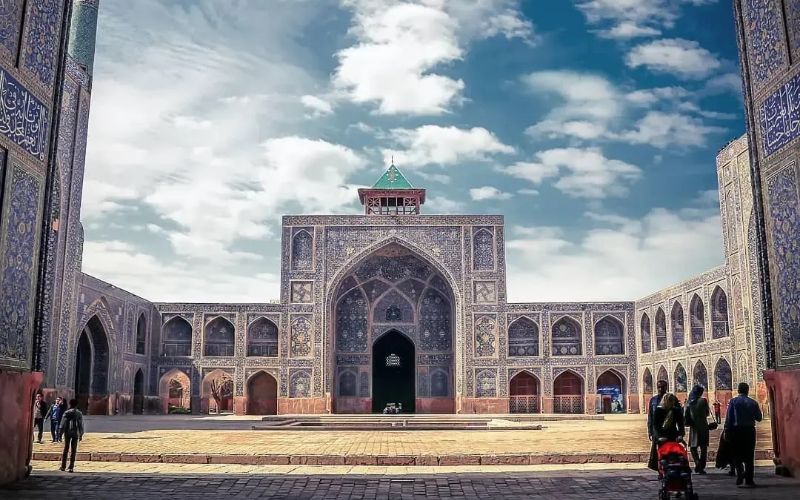In a true oasis neighborhood of lovely Isfahan, one of the most ancient and religious structures of Persia exists. The magnificent Atiq Jameh Mosque of Isfahan is a combination of several architectural techniques from the different historical eras. This fact makes the building even more unique than it was. And don’t forget, you’re looking at a UNESCO World Heritage Site
Over 20000 square meters, this unique complex is one of the most important mosques in Iran and Islamic art. There is almost 2000 years of construction behind it, starting in the 8th century, which makes it one of the oldest mosques in Iran. It is said that before being a mosque, this place might have been a Zoroastrian temple. What makes it so unique is precisely the numerous evolutions over the centuries, and under four dynasties, of this congregational mosque.
Even before the time that this place became a mosque, it was a fire temple in the Sassanid era. Archeological discoveries, including a pillar bottom, have proven the pre-Islamic history of the building but the exact foundation date of it remains a mystery. The best estimation is, building this place dates back to 2000 years ago. Although other findings indicate that the final outward of this mosque mainly belongs to the Seljuq Dynasty, a renovation had been done during the Safavid Dynasty.
The Jammeh Mosque is the harmonious result of several reconstructions over time, additions and renovations, incorporating decorative elements of the various dynasties, from the Mongols to the Timurids and the Safavids. Thus, it’s not only a delight for the eyes, with its beautiful blue-tiles mosaics and domes, but it’s also a blend of Iranian history and the true embodiment of Persian architecture.
The first stones were put under the Abbasid Caliphate on the 8th century. On the following century, another mosque was built at the same location and the Buyid Dynasty started to make the first extensions. But the mosque’s core structure primarily dates back to the 11th century, under the great Seljuk Dynasty, which established Isfahan as their capital. At that era, the Turku-Persian Seljuk Empire dominated a region which stretched from Anatolia to the west of China
in their third capital Isfahan, they reshaped the Jammeh Mosque with its most important and stunning architectural features. They added new prayer rooms, with elaborated and delicate brickwork, but moreover, they built the mosque according to a plan which would become a prototype for Iranian and Central Asian’s mosques. This new architecture includes four iwans facing each other, around a tranquil opened central courtyard.
The iwans are the most iconic features of this mosque and are still used nowadays in Iranian mosques. An iwan is a gracious vaulted space, which opens on one side to the courtyard. These enormous opened arched faces each other on the north, south, east, and west sides. Developed in Pre-Islamic Iran, they were mainly used in monumental and imperial architecture. But in Isfahan’s Jammeh Mosque, they became for the first-time part of an Islamic religious building.
On the southern side of the mosque, the Qibla Iwan, which indicates the direction of the Mecca, is surrounded by two thin blue minarets. This recognizable element was meant to easily find the direction of prayer within the mosque. These four massive portals have been decorated with the finest Persian tilework. They are covered with sumptuous ceramic designs, arabesques and calligraphies, assembled pieces by pieces by the most skilled craftspeople of that time. The elaborate ornamentation of the iwans contrasts with the simplicity and sobriety of the mosque’s decoration.
Archaeology excavations show that Congregational Mosque was an important religious center in the city before even Arabs dominate Isfahan City, and was used as a Zoroastrian fire temple. During Jammeh Mosque of Isfahan History, the niche was destructed in third century AH and the direction of Qibla was corrected.
Jameh Mosque of Isfahan Architecture has been designed based on the four Iwan plan. The Iwans signify one of the interesting techniques of Iranian architecture through vaulted ornaments named Muqarnas (niche-like cells).
Atigh Mosque includes different entrances, each connecting the mosque’s space to different parts of the surrounding areas. Congregational Mosque of Isfahan Entrances are decorated with Mugharnas, friezes and great tile-workings. Friezes include verses from Quran or sayings from prophets and Imams.
Masjed Jammeh was partly damaged by Iraqi fighter bombers in 1985 during the 8 years of the Iran- Iraq war. The ceiling which collapsed were renovated promptly by the cultural heritage organization
Decoration and Interior design
Interior appearance of the court yard in Atigh Mosque and its tile works dates back to ninth century AH and the minarets are also of the same period. Spectacular features of Atigh Mosque of Isfahan Architecture include the exquisite tile-working of the vaulted ornaments, detailed plaster-moldings, beautiful columns and friezes.
The Current Great Mosque of Isfahan Plan Includes the Following Parts:
The mosque’s prayer gallery
Southern dome
northern dome
Darvish Iwan
Saheb Iwan
Ostad Iwan
Shagerd Iwan
Omar Iwan
Oljayto Iwan
Beit-al-shata winter prayer gallery
Khajeh Nezam-al-molk library
stoup of Darvish Iwan
stoup of Saheb Iwan
saheb iwan
the tile decoration of the saheb iwan consist of different styles representative of the eras of their construction
Darvish IWAN
It has superb brickwork with cross shaped design as well as plaster work and pendentive decoration the plaster carved inscription indicates a date of 1686
Shagerd iwan (student) and Ostad iwan (master)
These two iwans are both the same size but have different decorations
The shagerd iwan is adorned with tile work decoration and contains delicate and beautiful hanging adornment showing its seljuk features perfectly.
The ostad iwan consist of large and exquisite pendentives with geometrical tile work and the tile inscription indicates 1700.
THE Tajol Molk Dome
Its located in the far north of the mosque this unique mosque is an egg-shaped structure. the dome was the project of the queen malekshah, tarkan khatun.
The Muzaffarid School
This place back to 14 century and located on the northeast side of the shagerd iwan and include some rare examples of faience mosaic of this period.



Comment (0)